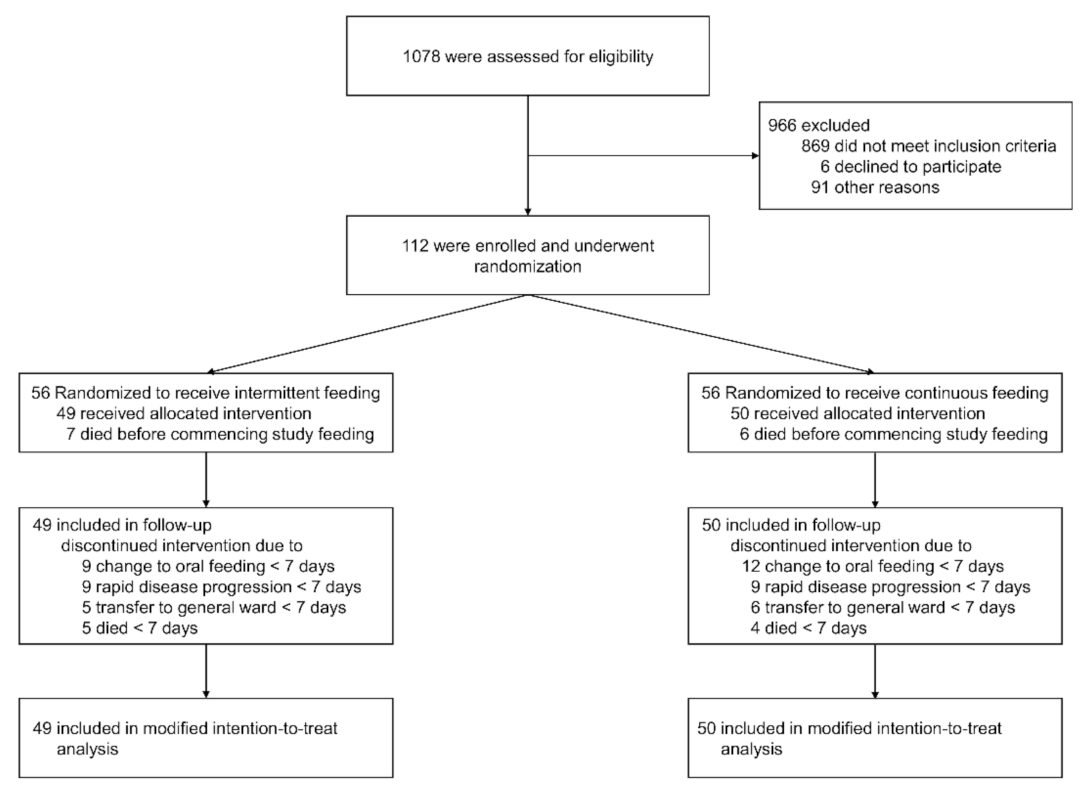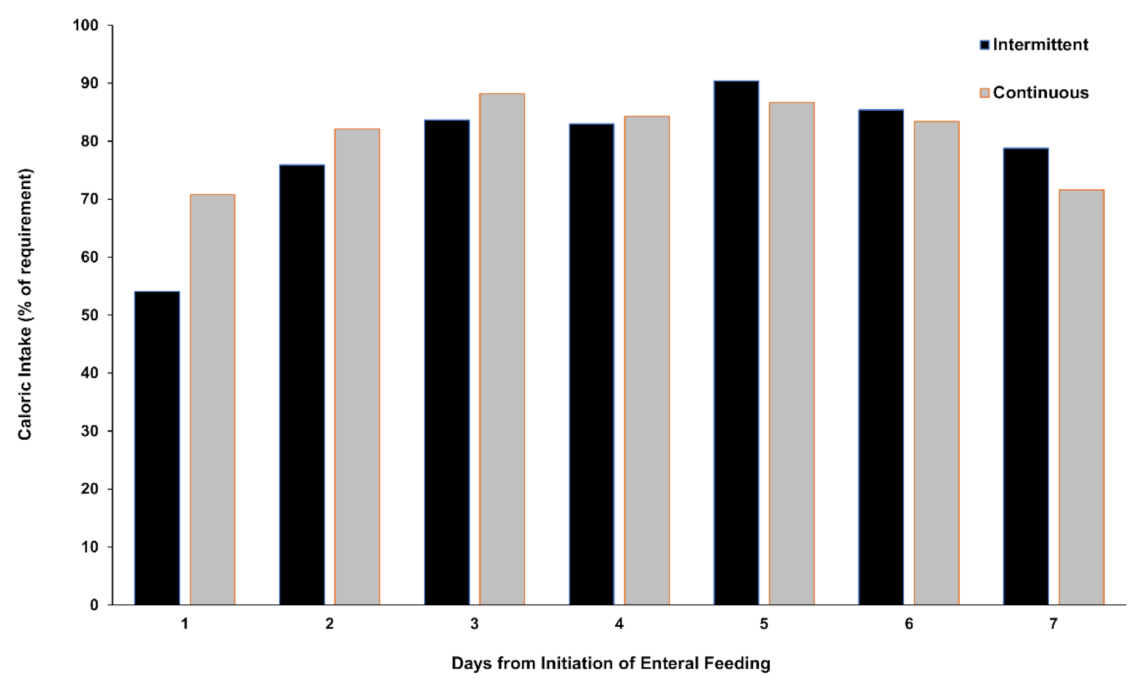Continuous versus Intermittent Enteral Tube Feeding for Critically Ill Patients: A Prospective, Randomized Controlled Trial
Abstract
:1. Introduction
2. Materials and Methods
2.1. Study Design, Setting, and Ethical Considerations
2.2. Participants
2.3. Randomization
2.4. Protocol
2.5. End Points
2.6. Statistical Analysis
3. Results
3.1. Participants of the Study
3.2. Participant Characteristics
3.3. Primary Outcome
3.4. Secondary Outcomes
4. Discussion
5. Conclusions
Supplementary Materials
Author Contributions
Funding
Institutional Review Board Statement
Informed Consent Statement
Data Availability Statement
Conflicts of Interest
References
- Wischmeyer, P.E. Overcoming challenges to enteral nutrition delivery in critical care. Curr. Opin. Crit. Care 2021, 27, 169–176. [Google Scholar] [CrossRef] [PubMed]
- Heyland, D.K.; Schroter-Noppe, D.; Drover, J.W.; Jain, M.; Keefe, L.; Dhaliwal, R.; Day, A. Nutrition support in the critical care setting: Current practice in canadian ICUs—Opportunities for improvement? JPEN J. Parenter. Enter. Nutr. 2003, 27, 74–83. [Google Scholar] [CrossRef] [PubMed]
- Dvir, D.; Cohen, J.; Singer, P. Computerized energy balance and complications in critically ill patients: An observational study. Clin. Nutr. 2006, 25, 37–44. [Google Scholar] [CrossRef] [PubMed]
- Mehta, N.M.; Bechard, L.J.; Cahill, N.; Wang, M.; Day, A.; Duggan, C.P.; Heyland, D.K. Nutritional practices and their relationship to clinical outcomes in critically ill children—An international multicenter cohort study. Crit. Care Med. 2012, 40, 2204–2211. [Google Scholar] [CrossRef] [PubMed]
- Heyland, D.K.; Stephens, K.E.; Day, A.G.; McClave, S.A. The success of enteral nutrition and ICU-acquired infections: A multicenter observational study. Clin. Nutr. 2011, 30, 148–155. [Google Scholar] [CrossRef]
- Villet, S.; Chiolero, R.L.; Bollmann, M.D.; Revelly, J.P.; Cayeux, R.N.M.; Delarue, J.; Berger, M.M. Negative impact of hypocaloric feeding and energy balance on clinical outcome in ICU patients. Clin. Nutr. 2005, 24, 502–509. [Google Scholar] [CrossRef]
- Cahill, N.E.; Dhaliwal, R.; Day, A.G.; Jiang, X.; Heyland, D.K. Nutrition therapy in the critical care setting: What is “best achievable” practice? An international multicenter observational study. Crit. Care Med. 2010, 38, 395–401. [Google Scholar] [CrossRef]
- Singer, P.; Blaser, A.R.; Berger, M.M.; Alhazzani, W.; Calder, P.C.; Casaer, M.P.; Hiesmayr, M.; Mayer, K.; Montejo, J.C.; Pichard, C.; et al. ESPEN guideline on clinical nutrition in the intensive care unit. Clin. Nutr. 2019, 38, 48–79. [Google Scholar] [CrossRef] [Green Version]
- Kocan, M.J.; Hickisch, S.M. A comparison of continuous and intermittent enteral nutrition in NICU patients. J. Neurosci. Nurs. 1986, 18, 333–337. [Google Scholar] [CrossRef]
- Patel, J.J.; Rosenthal, M.D.; Heyland, D.K. Intermittent versus continuous feeding in critically ill adults. Curr. Opin. Clin. Nutr. Metab. Care 2018, 21, 116–120. [Google Scholar] [CrossRef]
- Bear, D.E.; Hart, N.; Puthucheary, Z. Continuous or intermittent feeding: Pros and cons. Curr. Opin. Crit. Care 2018, 24, 256–261. [Google Scholar] [CrossRef] [PubMed]
- Brown, B.; Roehl, K.; Betz, M. Enteral nutrition formula selection: Current evidence and implications for practice. Nutr. Clin. Pract. 2015, 30, 72–85. [Google Scholar] [CrossRef] [PubMed] [Green Version]
- Wakita, M.; Masui, H.; Ichimaru, S.; Amagai, T. Determinant factors of the viscosity of enteral formulas: Basic analysis of thickened enteral formulas. Nutr. Clin. Pract. 2012, 27, 82–90. [Google Scholar] [CrossRef] [PubMed]
- McClave, S.A.; Taylor, B.E.; Martindale, R.G.; Warren, M.M.; Johnson, D.R.; Braunschweig, C.; McCarthy, M.S.; Davanos, E.; Rice, T.W.; Cresci, G.A.; et al. Guidelines for the Provision and Assessment of Nutrition Support Therapy in the Adult Critically Ill Patient: Society of Critical Care Medicine (SCCM) and American Society for Parenteral and Enteral Nutrition (A.S.P.E.N.). JPEN J. Parenter. Enter. Nutr. 2016, 40, 159–211. [Google Scholar] [CrossRef]
- Dhaliwal, R.; Cahill, N.; Lemieux, M.; Heyland, D.K. The Canadian critical care nutrition guidelines in 2013: An update on current recommendations and implementation strategies. Nutr. Clin. Pract. 2014, 29, 29–43. [Google Scholar] [CrossRef]
- Mackenzie, S.L.; Zygun, D.A.; Whitmore, B.L.; Doig, C.J.; Hameed, S.M. Implementation of a nutrition support protocol increases the proportion of mechanically ventilated patients reaching enteral nutrition targets in the adult intensive care unit. JPEN J. Parenter. Enter. Nutr. 2005, 29, 74–80. [Google Scholar] [CrossRef]
- Rhoney, D.H.; Parker, D., Jr.; Formea, C.M.; Yap, C.; Coplin, W.M. Tolerability of bolus versus continuous gastric feeding in brain-injured patients. Neurol. Res. 2002, 24, 613–620. [Google Scholar] [CrossRef]
- Hiebert, J.M.; Brown, A.; Anderson, R.G.; Halfacre, S.; Rodeheaver, G.T.; Edlich, R.F. Comparison of continuous vs intermittent tube feedings in adult burn patients. JPEN J. Parenter. Enter. Nutr. 1981, 5, 73–75. [Google Scholar] [CrossRef]
- Evans, D.C.; Forbes, R.; Jones, C.; Cotterman, R.; Njoku, C.; Thongrong, C.; Tulman, D.; Bergese, S.D.; Thomas, S.; Papadimos, T.J.; et al. Continuous versus bolus tube feeds: Does the modality affect glycemic variability, tube feeding volume, caloric intake, or insulin utilization? Int. J. Crit. Illn. Inj. Sci. 2016, 6, 9–15. [Google Scholar] [CrossRef] [Green Version]
- MacLeod, J.B.; Lefton, J.; Houghton, D.; Roland, C.; Doherty, J.; Cohn, S.M.; Barquist, E.S. Prospective randomized control trial of intermittent versus continuous gastric feeds for critically ill trauma patients. J. Trauma 2007, 63, 57–61. [Google Scholar] [CrossRef] [Green Version]
- McNelly, A.S.; Bear, D.E.; Connolly, B.A.; Arbane, G.; Allum, L.; Tarbhai, A.; Cooper, J.A.; Hopkins, P.A.; Wise, M.P.; Brealey, D.; et al. Effect of Intermittent or Continuous Feed on Muscle Wasting in Critical Illness: A Phase 2 Clinical Trial. Chest 2020, 158, 183–194. [Google Scholar] [CrossRef] [PubMed]
- Ma, Y.; Cheng, J.; Liu, L.; Chen, K.; Fang, Y.; Wang, G.; Zhu, J.; Chen, L. Intermittent versus continuous enteral nutrition on feeding intolerance in critically ill adults: A meta-analysis of randomized controlled trials. Int. J. Nurs. Stud. 2021, 113, 103783. [Google Scholar] [CrossRef]
- Van Dyck, L.; Casaer, M.P. Intermittent or continuous feeding: Any difference during the first week? Curr. Opin. Crit. Care 2019, 25, 356–362. [Google Scholar] [CrossRef] [PubMed]
- Tatucu-Babet, O.A.; Fetterplace, K.; Lambell, K.; Miller, E.; Deane, A.M.; Ridley, E.J. Is Energy Delivery Guided by Indirect Calorimetry Associated with Improved Clinical Outcomes in Critically Ill Patients? A Systematic Review and Meta-analysis. Nutr. Metab. Insights 2020, 13, 1178638820903295. [Google Scholar] [CrossRef] [PubMed]


| Intermittent Feeding (n = 49) | Continuous Feeding (n = 50) | p-Value | |
|---|---|---|---|
| Age, years | 66.2 ± 12.7 | 67.5 ± 10.3 | 0.565 |
| Sex, male, n (%) | 33 (67.3) | 33 (66.0) | >0.999 |
| Body mass index, kg/m2 | 22.0 ± 3.9 | 23.3 ± 3.9 | 0.107 |
| Primary diagnosis, n (%) | 0.210 | ||
| Respiratory failure | 39 (79.6) | 43 (86.0) | |
| Cardiac arrest | 6 (12.2) | 2 (4.0) | |
| Sepsis or septic shock | 2 (4.1) | 4 (8.0) | |
| Other | 2 (4.1) | 1 (2.0) | |
| Comorbidities, n (%) | |||
| Cardiovascular disease | 16 (32.7) | 20 (40.0) | 0.582 |
| Diabetes mellitus | 15 (30.6) | 15 (30.0) | >0.999 |
| Chronic lung disease | 21 (42.9) | 17 (34.0) | 0.484 |
| Chronic kidney disease | 7 (14.3) | 10 (20.0) | 0.626 |
| Chronic liver disease | 7 (14.3) | 5 (10.0) | 0.730 |
| Malignancy | 21 (42.9) | 23 (46.0) | 0.911 |
| Immunodeficiency | 21 (42.9) | 19 (38.0) | 0.774 |
| Chronic neurologic disease | 6 (12.2) | 5 (10.0) | 0.972 |
| Median time from ICU admission to randomization (IQR), h | 15.9 (7.2–25.7) | 15.9 (7.5–23.4) | 0.552 |
| APACHE II score | 27.7 ± 9.3 | 28.6 ± 8.0 | 0.620 |
| SOFA score | 9.1 ± 4.4 | 8.6 ± 4.1 | 0.560 |
| Ongoing treatments at randomization, n (%) | |||
| Mechanical ventilation | 49 (100) | 50 (100) | >0.999 |
| Renal replacement therapy | 9 (18.4) | 8 (16.0) | 0.963 |
| Vasopressor therapy | 26 (53.1) | 23 (46.0) | 0.616 |
| Systemic corticosteroid therapy | 34 (69.4) | 28 (56.0) | 0.242 |
| Anti-infectious treatment | 47 (95.9) | 50 (100) | 0.466 |
| Sedative drugs | 29 (59.2) | 31 (62.0) | 0.935 |
| Analgesic drugs | 45 (91.8) | 45 (90.0) | >0.999 |
| Energy target (kcal/day) | 1380 ± 172 | 1426 ± 201 | 0.220 |
| Energy target per ideal body weight (kcal/kg/day) | 24.1 ± 2.9 | 24.7 ± 2.9 | 0.309 |
| Laboratory variables | |||
| Serum creatinine, mg/dL | 1.06 (0.64–1.85) | 1.08 (0.78–1.76) | 0.788 |
| Lactate, mmol/L | 2.2 (1.6–3.4) | 2.0 (1.5–3.9) | 0.841 |
| C-reactive protein, mg/dL | 13.4 (7.6–22.5) | 13.3 (5.0–25.7) | 0.975 |
| Serum albumin, mg/dL | 2.8 (2.4–3.0) | 2.6 (2.3–3.0) | 0.586 |
| Glucose, mg/dL | 167 (131–220) | 172 (115–237) | 0.804 |
| Intermittent Feeding (n = 49) | Continuous Feeding (n = 50) | Relative Risk (95% CI) | p-Value | |
|---|---|---|---|---|
| Primary outcome | ||||
| ≥80% of the target requirement, achievement days/total days of feeding (%) | 119/227 (52.4) | 147/226 (65.0) | 1.24 (1.06–1.45) | 0.008 |
| Secondary outcomes | ||||
| ICU mortality, n (%) | 24 (49.0) | 16 (32.0) | 0.65 (0.40–1.07) | 0.129 |
| Death within 28 days, n (%) | 26 (53.1) | 21 (42.0) | 0.79 (0.52–1.20) | 0.368 |
| Median length of hospital stay (IQR), days | ||||
| In-hospital survivors | 25 (17–33) | 22 (11–38) | 0.763 | |
| In-hospital nonsurvivors | 9 (4–15) | 10 (6–19) | 0.603 | |
| Median length of ICU stay (IQR), days | ||||
| ICU survivors | 8 (5–11) | 6 (3–11) | 0.443 | |
| ICU nonsurvivors | 6 (3–10) | 7 (4–12) | 0.782 | |
| Gastrointestinal intolerance, n (%) | ||||
| Diarrhea | 22 (44.9) | 22 (44.0) | 0.98 (0.63–1.52) | >0.999 |
| Constipation | 22 (44.9) | 28 (56.0) | 1.25 (0.84–1.85) | 0.366 |
| Vomiting or regurgitation | 8 (16.3) | 7 (14.0) | 0.86 (0.34–2.18) | 0.966 |
| Abdominal pain or distension | 8 (16.3) | 3 (6.0) | 0.37 (0.10–1.30) | 0.189 |
| Aspiration | 0 (0) | 2 (4.0) | 4.90 (0.24–99.57) | 0.484 |
| Received prokinetic drugs | 12 (24.5) | 19 (38.0) | 1.55 (0.85–2.84) | 0.218 |
| Days without mechanical ventilation a | 0 (0–20) | 11 (0–20) | 0.142 | |
| Days without dialysis a | 11 (0–28) | 24 (7–28) | 0.077 | |
| Days without vasopressor support a | 11 (0–24) | 19 (4–26) | 0.062 |
Publisher’s Note: MDPI stays neutral with regard to jurisdictional claims in published maps and institutional affiliations. |
© 2022 by the authors. Licensee MDPI, Basel, Switzerland. This article is an open access article distributed under the terms and conditions of the Creative Commons Attribution (CC BY) license (https://creativecommons.org/licenses/by/4.0/).
Share and Cite
Lee, H.-Y.; Lee, J.-K.; Kim, H.-J.; Ju, D.-L.; Lee, S.-M.; Lee, J. Continuous versus Intermittent Enteral Tube Feeding for Critically Ill Patients: A Prospective, Randomized Controlled Trial. Nutrients 2022, 14, 664. https://doi.org/10.3390/nu14030664
Lee H-Y, Lee J-K, Kim H-J, Ju D-L, Lee S-M, Lee J. Continuous versus Intermittent Enteral Tube Feeding for Critically Ill Patients: A Prospective, Randomized Controlled Trial. Nutrients. 2022; 14(3):664. https://doi.org/10.3390/nu14030664
Chicago/Turabian StyleLee, Hong-Yeul, Jung-Kyu Lee, Hye-Jin Kim, Dal-Lae Ju, Sang-Min Lee, and Jinwoo Lee. 2022. "Continuous versus Intermittent Enteral Tube Feeding for Critically Ill Patients: A Prospective, Randomized Controlled Trial" Nutrients 14, no. 3: 664. https://doi.org/10.3390/nu14030664
APA StyleLee, H.-Y., Lee, J.-K., Kim, H.-J., Ju, D.-L., Lee, S.-M., & Lee, J. (2022). Continuous versus Intermittent Enteral Tube Feeding for Critically Ill Patients: A Prospective, Randomized Controlled Trial. Nutrients, 14(3), 664. https://doi.org/10.3390/nu14030664





